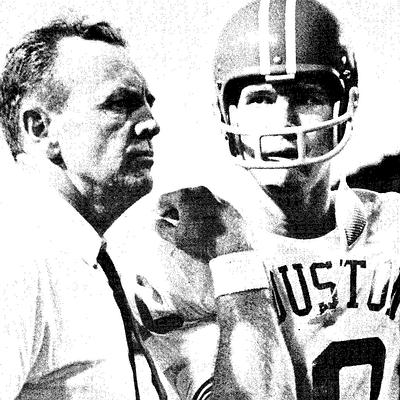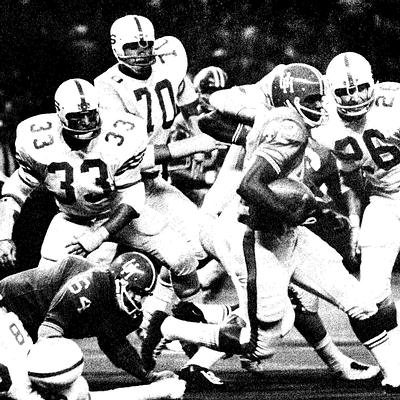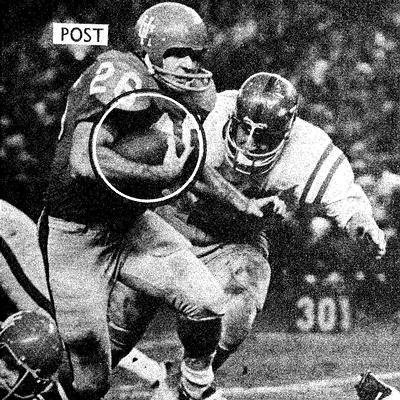Established as Houston Junior College in 1927, located
in the building of San Jacinto High School, and offering
night classes only, it has been a long and uphill climb
for the University Of Houston. Renamed when it became a
four-year college in 1934, the campus bounced around the
city, housed in a number of churches until it was finally
re-located to its current campus site in 1939. As a
private school, it remained a step-sister to the larger
and better endowed football playing state schools
throughout Texas and eventually faced dwindling
enrollment. Despite fierce opposition from the two major
state universities, Houston was made a part of the state
educational system in 1963. Derisively referred to as
"Cougar High" by many, Houston surprisingly has a number
of highly regarded academic programs. Their MBA program is
ranked fifth nationally, tied with Michigan and Dartmouth
for the number of CEOs among the top S&P 500 companies and
it is respected for its internationally known school of
architecture and research facilities. Yet, the football
team was always looked down upon as were its academics. As
hard as Texas and Texas A&M fought to prevent the
University Of Houston from joining the state educational
system and with that acceptance, a piece of the
legislative budget, it did all it could to prevent its
inclusion to the Southwest Conference.
As the Houston Cougars entered the early sixties, they
still had a reputation in the football community as
somewhat of an outlaw school. In part, this was due to the
propaganda pushed by in-town neighbor Rice University and
both Texas and A&M, in part to the scheduling of a broad
range of other schools, and perhaps primarily because they
were seen as a rag-tag collection of athletes that could
not cut it at other institutions of higher learning. Hogan
Wharton, the very tough 1958 All American tackle who later
starred at offensive guard for the first three Houston
Oiler teams, stated "Burr Davis, Harold Lewis, John
Peters, and Bob Borah were about the only ones who hadn't
transferred from another school." Wharton himself was an
SMU transfer who was All Missouri Valley two times and
Conference Lineman Of The Year. When Bill Yeoman took the
head coaching reins from Hal Lahar in 1962, the team
already owned a reputation of "intellectually challenged
drop-outs from other schools". Wharton admitted that "We
were a bunch of rowdies" and some of the fellows may not
have provided a first-impression of an erudite college
man. "One day in our meeting Andy Zubel (an assistant)
tells us 'We're going to attack these people
methodically'. Then he asks Don Boudreaux, 'Do you know
what that means/' Boudreaux tells him, 'Yes sir, bordering
on mediocrity.'" Another coach informed the team that "Out
of this formation, they do two things-run or pass."
The outlaw reputation only increased because of the
team's rugged style of play, enhanced by the hiring of
Bill Yeoman as head coach in 1962. Yeoman was a
multi-sport athlete at Texas A&M as a frosh in 1945 and
had fouled out of twenty-four of the thirty basketball
games he played in during the 1945 season and his squads
reflected this "take no prisoners" attitude. Specific to
the series with Cincinnati, the 1957 game ended with what
was termed " the biggest gang fight on the field you ever
saw..." and later continued as the Cougars and Bearcats
squared off on the bus that was taking the Houston team to
the airport. The 1957 game was the start of a six game
series that ran through 1962 and Houston won every game.
Yeoman did push to break new ground after the success he
experienced as an assistant on Duffy Daugherty's Michigan
State staff and his toughness made him more impervious to
criticism than most. He received a commission to West
Point in 1946 and was Army's team captain in '48 on a
squad that went 22-2-4 in his three-year period. Serving
in the Army through the Korean War, he was discharged in
1953 and spent 1954 through '61 on the Spartan staff.
Daugherty was known for recruiting southern and Texan
African-American players when schools in their home states
would not think of allowing a Black player on the
gridiron. Yeoman broke the color barrier in the Southwest
by signing Houston's first African-American player to a
football scholarship on July 11, 1964. That the specific
player was Warren McVea of San Antonio, perhaps the most
highly recruited player in the nation, provided tremendous
impact and notoriety.
The game in 1964 with Cincinnati was played at Houston
and came after the announcement that once again, Houston
would be denied entrance to the SWC. Promised support by
Rice, it was not forthcoming and Texas and Texas A&M again
prevailed by preventing expansion of the conference. This
didn't prevent the Cougars from putting a tremendous
amount of talent onto the field but may have played a role
in the disappointing 2-6-1 record. That one of those
victories was a 10-0 decision over A&M made it more
palatable but Cincinnati QB Brig Owens and HB Al Nelson
guided the Bearcats to a 20-6 decision over Houston.
Because the Bearcats tied a loaded Tulsa team for the
Missouri Valley Conference crown, this wasn't considered
an upset. Owens of course played many top-level seasons
with the Redskins and Nelson did the same with the Eagles,
both at defensive backfield positions but some of the
locals were surprised that their hometown Cougars had
suffered through consecutive two-win seasons. 1964 marked
the introduction of a brand new offense that Yeoman
developed and the adaptation to it also limited the attack
but the Veer was born and would later prove to be one of
the era's most effective schemes.
Houston took the field in bright red helmets with a
white interlocking "UH" decal on each side and red jerseys
with white front, back, and sleeve numbers. They always
looked big because relative to a lot of the other
southwest area teams, they did have more size and the
level of increased aggressiveness they seemed to display
was always a consideration. The
1965 game was highly anticipated because it would be
played indoors, at the brand new Houston Astrodome. The
so-called "Eighth Wonder Of The World", the first indoor
stadium, wasn't, and a frequently overlooked fact is that
the field was dirt and rocks! To reduce glare produced by
sunlight streaming through the glassed roof which played
havoc with fly balls during the inaugural baseball season,
it was painted over with green paint. This certainly
reduced the level of glare but also prevented any grass
from growing, thus, the first football season at the
Astrodome often necessitated constant watering of the
field of play to prevent the players from being obscured
in a cloud of dust. Having been shut out in their first
two games against Tulsa and Mississippi State, the Cougs
opened up a twenty-one point fourth quarter barrage
against UC to win 21-6. While McVea was the big name, he
was a bit of a disappointment and had not yet found his
more effective position at running back, staying almost
exclusively at the flank. The Bearcats' Denny Matthews
blanketed him very effectively. However, '64's leading
rusher Dick Post was a tough runner who later proved his
worth with the Chargers and was well-known in NFL circles
as a "fashion plate", so much so that he eventually opened
up his own clothing store in San Diego that was known for
having the hippest of "mod threads." Tom Beer was an
effective TE who had transferred to Houston when Detroit
Mercy University dropped football. UC had also benefited
from that unfortunate situation when the respected
Catholic university could no longer fund the program as QB
Mike Flaherty and others transferred in with the ability
to play immediately. Beer played a six-year pro career
with the Broncos and Patriots and later played and became
a front office administrator in the WFL. The Cougars
had improved to 4-5-1.
Houston changed its helmet for the '66 season,
maintaining the white interlocking U and H on the sides of
the headgear but adding two white flanking stripes around
the one-inch red center stripe, a great look. Thank
goodness the series with the Bearcats took a two-year
sabbatical because the Veer really kicked in on the brand
new $250,000.00 artificial grass rug that was laid upon
the Astrodome floor. Everyone who played there noted that
it was like playing on concrete and that one's forearms
would be torn to shreds sliding across the plastic carpet.
Most of the jerseys still had three-quarter length sleeves
but it wasn't until part-way through the season that
visiting teams realized that some sort of padding was
necessary to avoid severe skin damage and in some cases,
eventual staph infections! Post became Houston's first
1000-yard rusher in fifteen seasons, McVea seemed to learn
how to utilize his great speed and elusiveness, and the
team ran up an 8-2 record with a monster seventy-three
points laid upon Tulsa. The '67 season finished at 7-3
with a seventy-seven point outburst against Idaho and when
the UC vs. Houston series resumed in 1968, the Cougars'
6-2-2 record included ridiculous offensive numbers.
Consider scores of 54-7 (vs. Tulane), 77-3 (against Idaho,
the second consecutive year they ran up seventy-seven
points on the Vandals), a scorching 100-6 mark against
Tulsa, and a record-setting offensive outburst vs.
Cincinnati in a 71-33 triumph. The high-powered Veer as
the expression went "was all of that!"
History shows that once Houston was accepted as a
member of the SWC, they immediately made all of the other
conference members pay for not allowing them in sooner.
They swept in and won the conference title but with the
break up of the SWC, now find themselves in the
competitive Conference USA where they remain an offensive
powerhouse.




